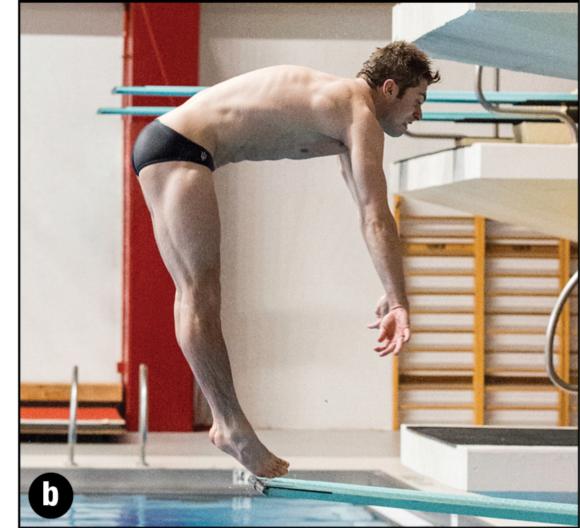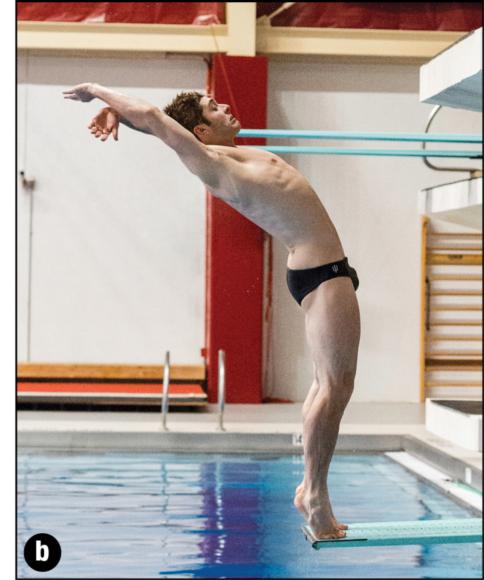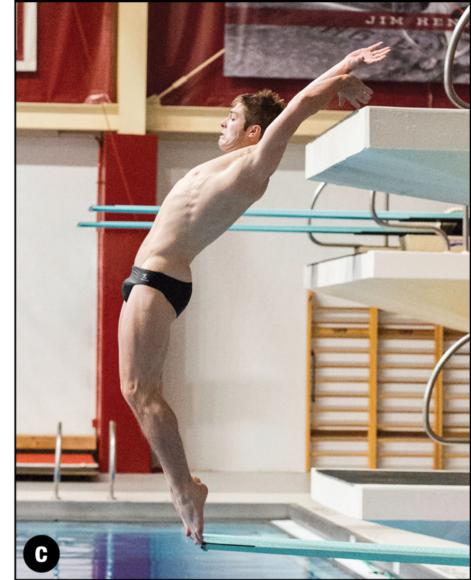Takeoffs
This is an excerpt from Springboard and Platform Diving by Jeff Huber.
The reason for revisiting the magic position is that the following essential positions for the takeoff are impossible to attain to any degree of proficiency without first establishing the magic position. From the magic position, there are five basic takeoff positions for springboard and platform takeoffs. They are described in the following sections.
90-90-90 Position
The first essential position for the takeoff is the 90-90-90 position, which comprises three 90-degree angles and is used for all forward and inward somersaulting dives. Many divers and coaches mistakenly believe that the diver should wait until off the board to throw for a somersault. This is not the case. The throw should occur while still on the board.
The easier the dive is, the less the 90-90-90 position is required. A diver performing a forward single somersault, for example, doesn't need to achieve this position because the dive will rotate faster than necessary. For other dives, however, such as a forward 2 1/2 or 3 1/2 somersault, this position is critical for success. The more difficult the dive is, the more necessary the 90-90-90 position becomes. The diver should begin throwing when the board is fully depressed to attain the position.
 |
 |
The first essential position for (a) forward and (b) inward takeoffs: the 90-90-90 position.
Take note in figure a that the legs are straight and the diver has extended through the ankles. The push through the ankles finishes the leg push and further drives the hips upward to form the 90-90-90 position while the diver is still on the board. As we will see in the takeoff position for reverse and backward somersaulting dives, the push through the feet plays an equally important role in those dives as well.
Head Pop Position
Also notice in figure a that the diver is looking forward rather than down at the water. The diver does not have the chin down into the chest, as many beginning and intermediate divers make the mistake of doing. In achieving the 90-90-90 position, the diver establishes the second essential position, the head pop position, by popping the head up as the arms and chest move down to form the third 90-degree angle. Although there is a slight lifting of the head, the head pop is primarily achieved by keeping the head in a neutral position and fixating on a point of reference during the throw. Many divers, however, feel as if they are popping the head.
The reason for this head pop is fourfold. The first has to do with Sir Isaac Newton and his famous third law: For every action there is an equal and opposite reaction. In response to the force of the head moving backward, the hips (i.e., center of gravity) move forward in the direction of the rotation. This reaction is better understood by examining figure a.

Newton's third law and the second essential position for forward and inward takeoffs during the 90-90-90 position: the head pop position.
The second reason for the head pop is spatial orientation. The vestibular system, located within the ears, helps divers determine up and down. By keeping the head up, divers maintain better spatial orientation during dive rotation. The third reason for the head pop is that keeping the head up in the dive makes it easier for divers to pick up their visual cues during dive rotation (i.e., spotting). If the chin is buried on the chest, divers are unlikely to see much during dive rotation.
Finally, the fourth reason for the head pop has to do with the entry. It is a rule of thumb in diving that if the diver's head is down getting into the dive, it will tend to be down getting out of the dive. This down head down position often causes divers to miss seeing the water or to reach under (i.e., past their water entry point) and rotate past vertical on forward and inward entries into the water.
Many divers make the mistake of popping the head too early: they pop the head and then throw instead of throw and then pop the head. By initiating the head pop too early, they don't achieve the action - reaction effect and the head usually drops down in the 90-90-90 position. In analyzing figure a, notice that the head pop occurs when the legs and torso form a 90-degree angle.
C Position
The third essential position is the C position, which occurs when the diver forms a C shape with the body on takeoff for backward (figure b) and reverse (figure c) somersaulting dives. The C shape begins at the toes and follows through the body to the tips of the fingers. Notice that the fingertips point approximately at 2 or 3 o'clock. The more rotation the diver performs, the farther back the diver should reach. For a reverse 1 1/2, for example, a diver may reach to 1 or 2 o'clock, but for a reverse 2 1/2 or 3 1/2, the diver may reach to approximately 2 or 3 o'clock.
Some divers mistakenly conceptualize the C as beginning from the waist, instead of the toes, and extending through the arms. The C position, however, is formed using the entire body. It is established by pushing the hips forward rather than pulling the shoulders backward. Pulling the shoulders causes the diver to pull into the board for reverse somersaulting dives and to pull too far away from the board on backward somersaulting dives.
Notice in figure c that the chin is touching or almost touching the chest. In achieving the C position, the head remains neutral and the chest opens up to touch the chin. Many divers feel as if they are pushing the chin down, but they are actually holding it still. If the chin isn't down and touching or nearly touching the chest, the diver is pulling the head upward and backward.
During the arm swing, the arms bend approximately 90 degrees between 11 and 12 o'clock and then, most important, straighten back out to complete the fully formed C position. Finally, notice that the extension through the ankles pushes the hips forward and upward and significantly contributes to forming the C position.
 |
 |
The third essential position for (b) backward and (c) reverse takeoffs for somersaulting dives: the C position.
Learn more about Springboard and Platform Diving.
More Excerpts From Springboard and Platform DivingSHOP

Get the latest insights with regular newsletters, plus periodic product information and special insider offers.
JOIN NOW
Latest Posts
- Using double inclinometers to assess cervical flexion
- Trunk flexion manual muscle testing
- Using a goniometer to assess shoulder horizontal adduction
- Assessing shoulder flexion with manual muscle testing
- Sample mental health lesson plan of a skills-based approach
- Sample assessment worksheet for the skill of accessing valid and reliable resources


